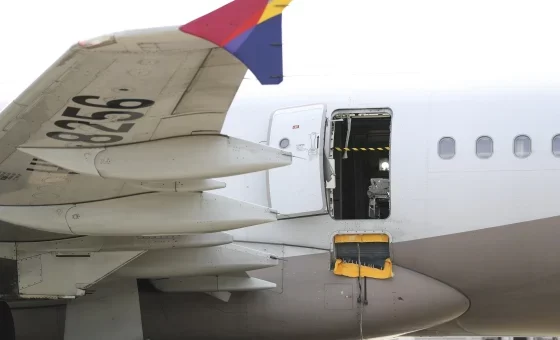
Foreign Airline Passenger Opens Emergency Door Midflight – Traveler Takes Matters into His Own Hands on Overseas Flight
SKOR – On May 26th, a man traveling on a 60-minute Asiana Airline domestic flight from Jeju Island to Daegu, South Korea, began to feel claustrophobic three minutes before landing. With no regard for airline safety, he released the emergency door from approximately 700 feet above the ground!
Footage of the incident shows the door of the A321-200 jet opening as it approached the runway at Daegu International Airport, located approximately 150 miles southeast of Seoul. A video posted on social media, apparently taken by another passenger, shows travelers’ hair blown around by enormous winds entering the cabin when the emergency exit door was opened. Horrified travelers grip their armrests in fear. Thankfully for the passengers and the global aviation market as a whole, the aircraft landed safely.
Lee Yoon-Joon, 33 years old, was quickly taken into custody by local police at Daegu airport. According to Yonhap News Agency, he explained that he had been under a great deal of pressure after losing his job. He also did not like the passenger seated beside him, as he had an unpleasant odor. Then anxiety kicked in, and he was sure he was going to die. Feeling overwhelmed, Lee hastily decided to let himself off the aircraft. The flight crew initially thought the door opened due to a mechanical issue. It’s good that they soon spotted Lee and swiftly apprehended him.
Asiana Airlines reported that a total of 194 passengers, including a track and field team of teenagers on their way to a competition, were onboard. Twelve people were taken to a local hospital, and nine were admitted after suffering minor injuries from hyperventilation from the incident. With all the turbulence and noise, it must have been extremely frightening. At least nobody got sucked out the door, like in some type of screenplay by Stephen King.
According to the FAA, many aircraft are designed to be flown even if the door has been completely removed. The pilot should stay on course, and no one should try to fix the problem until they are safely on land.
An aviation safety inspector was sent to the scene by South Korean law enforcement to investigate if there were any irregularities in aircraft maintenance. The fact that the door behind the wing opened mid-flight is quite peculiar, as they are designed to stay closed while in the air. Yet, the passenger had no trouble unfastening it while traveling at a speed of 172 mph. Sounds technically impossible?
According to Patrick Smith’s book Cockpit Confidential, it is not possible to “open the doors or emergency hatches of an airplane in flight. You can’t open them for the simple reason that cabin pressure won’t allow it. Think of an aircraft door as a drain plug fixed in place by internal pressure. Almost all aircraft exits open inward. Some retract upward into the ceiling; others swing outward, but they open inward first, and not even the most musclebound human will overcome the force holding them shut. At a typical cruising altitude, up to eight pounds of pressure are pushed against every square inch of the interior fuselage. That’s over 1,100 pounds against each square foot of the door.”
Apparently, that’s not always the case. A representative of Asiana Airlines explained that the plane is programmed to regulate the cabin pressure based on its altitude. When the aircraft is high up, the door cannot be opened. However, when it is close to landing at a low altitude, it is possible for the door to be opened.
A Korean safety official, Jin Seong-hyun, claimed that he had never heard of anything like tore, making it a first for global travel. While individuals have helped themselves to the emergency exit in the past, it was always while they were still on the ground.
As a result of the mishap in South Korea, Asiana announced that it would no longer sell the emergency exit seats, 31A, and 26A, on its A321-200 jets as a precaution, regardless of whether the flight is full or not.
It is uncertain if the arrest of the culprit for allegedly violating aviation security laws in Daegu will prevent other passengers from attempting to open the emergency door. He may be looking at ten years behind bars. Too bad for his claustrophobia.